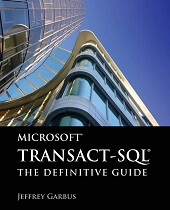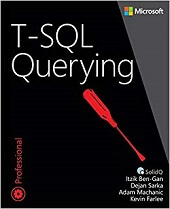This post may contain affiliate links. For more information visit our disclosure page
We have researched and compiled a list of the 10 Best T-SQL Books that can help you learn about every aspect of Transact-SQL. They are suitable for beginners, intermediate learners as well as experts. Many professionals have already benefited from this compilation, hope you do too!
Transact-SQL is Microsoft Corporation’s powerful implementation of the ANSI standard SQL database query language, which was designed to retrieve, manipulate, and add data to relational database management systems (RDBMS). It is used with Microsoft SQL Server and Azure SQL Database.
T-SQL is essential in writing SQL statements to get data into and out of a database. T-SQL is the foundation for business logic embedded in the database in the form of stored procedures and functions.
Best T-SQL Books You Should Read
- Our #1 Choice: T-SQL Fundamentals
- Best Value Pick: Beginning T-SQL: A Step-by-Step Approach
- Best Budget Pick: Sams Teach Yourself Microsoft SQL Server T-SQL in 10 Minutes
1. Beginning T-SQL: A Step-by-Step Approach
Beginning T-SQL is a performance-oriented introduction to the T-SQL language underlying the Microsoft SQL Server database engine. Beginning T-SQL starts you on the path to mastering T-SQL, with an emphasis on best-practices and sound coding techniques leading to excellent performance.
Author begins with an introduction to databases, normalization, and to SQL Server Management Studio. Attention is given to Azure SQL Database and how to connect to remote databases in the cloud.
Each subsequent chapter teaches an aspect of T-SQL, building on the skills learned in previous chapters. Exercises in most chapters provide an opportunity for the hands-on practice that leads to true learning and distinguishes the competent professional. Important techniques such as windowing functions are covered to help write fast executing queries that solve real business problems.
A stand-out feature in this book is that most chapters end with a “Thinking About Performance” section. These sections cover aspects of query performance relative to the content just presented. They’ll help you avoid beginner mistakes by knowing about and thinking about performance from Day 1.
Beginning T-SQL cover the essential features of T-SQL found in SQL Server 2014, 2012, and 2008.
2. Beginning T-SQL with Microsoft SQL Server 2005 and 2008

This book introduces the T-SQL language and its many uses and serves as a comprehensive guide at a beginner through intermediate level. If you are familiar with relational database concepts but are new to Microsoft SQL Server or the T-SQL language, this book will teach you the basics from the ground up. If you’re familiar with earlier versions of SQL Server, it will get you up-to-speed on the newest features.
Database solution designers will find this book to be a thorough introduction and comprehensive reference for all aspects of database modeling, design, object management, query design, and advanced query concepts.
Application developers who write code to manage and consume SQL Server data will benefit from our thorough coverage of basic data management and simple and advanced query design.
Database administrators who are new to SQL Server will find this book to be an all-inclusive introduction and reference of mainstream topics.
This book will help you to learn:
- How T-SQL provides you with the means to create tools for managing databases of different size, scope, and purpose
- Various programming techniques that use views, user-defined functions, and stored procedures
- Ways to optimize query performance
- How to create databases that will be an essential foundation to applications you develop later
3. T-SQL 2008 Joes 2 Pros: Core T-SQL Coding Fundamentals For Microsoft SQL Server 2008

With this book, you will get DVD and practice lessons. It also includes downloadable videos, good practical labs, Answers, and a Bug Catcher game at the end of each chapter where you have to find errors in the code so that you can easily catch up what is wrong with the code.
Full of good examples which gave a different perspective on databases.
4. Sams Teach Yourself Microsoft SQL Server T-SQL in 10 Minutes

This handy pocket guide starts with simple data retrieval and moves on to more complex topics, including the use of joins, subqueries, full text-based searches, functions and stored procedures, cursors, triggers, table constraints, XML, JSON, and much more.
You will learn how to…
- Use T-SQL in the Microsoft SQL Server environment
- Construct complex T-SQL statements using multiple clauses and operators
- Filter data so you get the information you need quickly
- Join two or more related tables
- Make SQL Server work for you with globalization and localization
- Create subqueries to pinpoint your data
- Retrieve, sort, and format database contents
- Automate your workload with triggers
- Create and alter database tables
- Work with views, stored procedures, and more
5. T-SQL Fundamentals

Author explains key T-SQL concepts and helps you apply your knowledge with hands-on exercises. The book first introduces T-SQL’s roots and underlying logic. Once you understand the logic behind T-SQL, you’ll quickly learn how to write effective code, whether you’re a programmer or database administrator.
Next, it walks you through core topics such as single-table queries, joins, subqueries, table expressions, and set operators. Then the book covers more-advanced data-query topics such as window functions, pivoting, and grouping sets. The book also explains how to modify data, work with temporal tables, and handle transactions, and provides an overview of programmable objects.
This book will help you to learn:
- Review core SQL concepts and its mathematical roots
- Create tables and enforce data integrity
- Insert, update, delete, and merge data
- Use transactions in a concurrent environment
- Perform effective single-table queries by using the SELECT statement
- Query multiple tables by using joins, subqueries, table expressions, and set operators
- Use advanced query techniques such as window functions, pivoting, and grouping sets
- Get started with programmable objects–from variables and batches to user-defined functions, stored procedures, triggers, and dynamic SQL
6. Microsoft Transact-SQL: The Definitive Guide

Some Topics covered include several ways of writing code for optimal performance and maintainability such as stored procedures versus dynamic SQL as well as subqueries versus joins; advanced SQL programming techniques including characteristic functions, common table expressions, refactoring, cubes, and dynamic queries; methods for identifying and fixing poorly written code including Profiler, DMVs, third-party tools, and reading query plans.
7. T-SQL Querying (Developer Reference)

All code and techniques are fully updated to reflect new T-SQL enhancements in Microsoft SQL Server 2014 and SQL Server 2012.
This book help you to write faster, more efficient T-SQL code.
What’s inside in this Book:
- Master an efficient top-down tuning methodology
- Assess algorithmic complexity to predict performance
- Compare data aggregation techniques, including new grouping sets
- Avoid date/time pitfalls that lead to buggy, poorly performing code
- Create optimized BI statistical queries without additional software
- Use programmable objects to accelerate queries
- Efficiently perform data-analysis calculations
- Make the most of T-SQL’s optimized bulk import tools
- Master useful and elegant approaches to manipulating graphs
- Unlock major performance improvements with In-Memory OLTP
8. Learn T-SQL Querying: A guide to developing efficient and elegant T-SQL code

Learn T-SQL Querying is more suitable for database administrators, database developers, data analysts, data scientists, and T-SQL practitioners who want to get started with writing T-SQL code and troubleshooting query performance issues, through the help of practical examples. Previous knowledge of T-SQL querying is not required to get started on this book.
The book will get you started with query processing fundamentals to help you write powerful, performant T-SQL queries. You will then focus on query execution plans and learn how to leverage them for troubleshooting.
In the later chapters, you will learn how to identify various T-SQL patterns and anti-patterns. This will help you analyze execution plans to gain insights into current performance, and determine whether or not a query is scalable. You will also learn to build diagnostic queries using dynamic management views (DMVs) and dynamic management functions (DMFs) to address various challenges in T-SQL execution.
Next, you will study how to leverage the built-in tools of SQL Server to shorten the time taken to address query performance and scalability issues. In the concluding chapters, the book will guide you through implementing various features, such as Extended Events, Query Store, and Query Tuning Assistant using hands-on examples.
By the end of this book, you will have the skills to determine query performance bottlenecks, avoid pitfalls, and discover the anti-patterns in use.
9. Pro T-SQL Programmer’s Guide

Fully functioning examples and downloadable source code bring technically accurate and engaging treatment of Transact–SQL into your own hands. Step–by–step explanations ensure clarity, and an advocacy of best–practices will steer you down the road to success.
Transact–SQL is the language developers and DBAs use to interact with SQL Server. It’s used for everything from querying data, to writing stored procedures, to managing the database. Support for in-memory stored procedures running queries against in-memory tables is new in the language and gets coverage in this edition. Also covered are must-know features such as window functions and data paging that help in writing fast-performing database queries.
10. Practical Guide for Oracle SQL, T-SQL and MySQL

The book’s unique side by side approach makes it easy for the reader to learn three major query languages in the IT industry. The author has over 20 years of experience in database design.
What’s inside in this Book:
- Contains numerous practical screenshots of Oracle SQL, T-SQL, MySQL statements and results.
- Shows the differences between Oracle SQL, T-SQL and MySQL side by side.
- Gives a real world experience for SQL developers and database administrators.
- Sample data is available to work on




